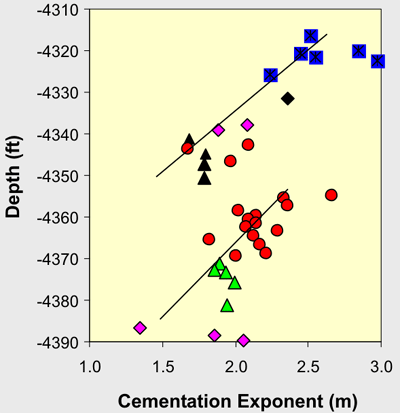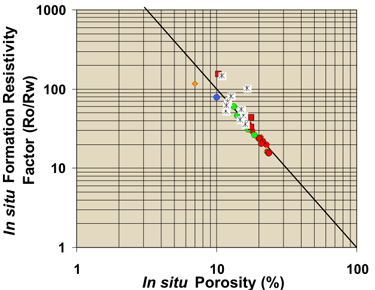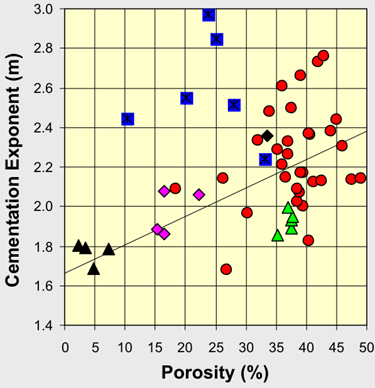Archie Cementation Exponents
Dolomites - Traditional wireline log calculation of saturations use the Archie equation and cementation (m) and saturation exponent (n) values of 2. Formation resistivity factors (Ro/Rw) measured at Rw=0.045 ohm-m (Figure) indicate that the Archie cementation exponent (assuming an Archie intercept of 1.0) averages m=1.97+0.09 for all facies. Echinoderm-rich facies can exhibit cementation exponents between 2.0 and 2.1. Vuggy cherts can exhibit cementation exponents between 2.1 and 2.2.
Chat - Chert conglomerates exhibit very high cementation exponent values with mavg=2.59+0.27. This is consistent with the high moldic and vuggy porosity in the clasts of this lithofacies. Autoclastic cherts exhibit a range in cementation exponent from m=1.68 to 2.76. Nodular to bedded cherts exhibit low cementation exponents ranging from m=1.86 to 1.99 with. Similarly, the dolomite mudstones and bioclastic wacke/ grainstones exhibit mavg = 1.97+0.11 and mavg = 1.77+0.05, respectively.
Variance in the cementation exponent of the autoclastic cherts can be explained partially by sponge-spicule mold content and vugginess at the plug scale but these are in turn related to position within the depositional cycle and/or position relative to the exposure surface or a perched water table.

Figure illustrates the relationship of cementation exponent with depth and lithofacies in the Tjaden 1-A WIW. The pattern in cementation exponent shown in Figure can be related to both deposition and exposure. Cementation exponents increase with increasing sponge-spicule mold content and vugginess. The basal interval exhibits a slight increase in sponge-spicule mold content upward in the section, terminating at the base of the overlying bioclastic wacke/grainstone. Autoclastic cherts interbedded with the bioclastic wacke/grainstones exhibit lower sponge-spicule mold content. As such, the cementation exponent-depth pattern may be related to deposition and sponge-spicule content.
Assuming the encrinite beds were lithified at the surface, they could be anticipated to act as aquitards and would be capable of forming the base of a perched water table. Within and immediately above a perched water table dissolution could be anticipated to be less than in the overlying vadose. With decreased vugginess in this wet interval, cementation exponents would be lower and would increase with proximity to the surface. Below the perched water table a saturation profile would also be established and the degree of vugginess and brecciation would decrease with increasing depth along with cementation exponents.
 |
 |
|
|
e-mail : webadmin@kgs.ku.edu
Last updated May 2003
http://www.kgs.ku.edu/PRS/publication/2003/ofr2003-32/P2-10.html
